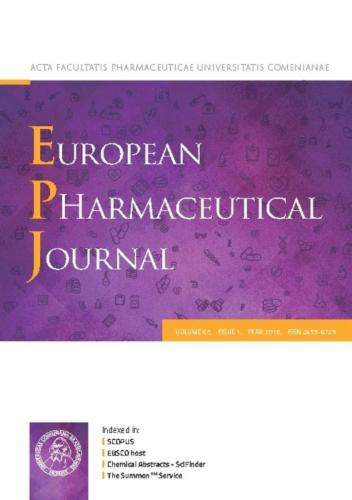增强喷雾干燥茶碱的肺输送:海藻糖和氨基酸组合作为创新精细载体的研究
IF 4.3
3区 医学
Q1 PHARMACOLOGY & PHARMACY
引用次数: 0
摘要
干粉吸入器新型载体系统的出现是一个极具吸引力的研究课题。此外,茶碱(THN)在肺部的特异性给药仍然具有挑战性。因此,本研究旨在利用成熟的喷雾干燥技术开发适当的精细载体,从而评估通过粉末吸入法将茶碱局部递送至肺深部治疗哮喘的潜力。初步研究的目的是开发新型的树胶糖基载体系统,并将其与氨基酸亮氨酸、甘氨酸和精氨酸结合在一起。对原料水溶液进行喷雾干燥,并对获得的微粒载体进行评估。随后,通过喷雾干燥含有候选开发载体的 10% THN 乙醇溶液,制备出治疗粉末。每个样品制备完成后,都要进行结构、热学、形态学、流变学、空气动力学和粒度分布表征。此外,还测定了 THN 的溶解度。通过使用相当于 10 毫克 THN 的样品,对体外药物释放和扩散、体外和硅学模拟肺沉积以及空气动力学颗粒计数进行了分析。综上所述,由含有亮氨酸或亮氨酸-甘氨酸组合的树胶糖组成的载体表现出卓越的可吸入特性,被认为是进一步开发的候选材料。与纯 THN 相比,THN 协同喷雾干燥样品的结晶结构较少,粒径为 4-5 µm,因此溶解度大幅提高(⁓20 倍),药物释放速度也更快(5 分钟内释放 100%)。体外和硅学空气动力学测量结果表明,THN-曲哈洛糖-亮氨酸组合具有显著增强的细颗粒部分(43%),导致更高的肺深部沉积(36%),空气动力学计数器证实了细颗粒的形成(平均值=3.61 µm)。此外,对 A549 细胞进行的体外实验表明,优化后的制剂具有较低的细胞毒性。本文章由计算机程序翻译,如有差异,请以英文原文为准。

Enhanced pulmonary delivery of spray-dried theophylline: investigation of the trehalose and amino acid combinations as innovative fine carriers
The emergence of novel carrier systems for dry powder inhalers is an attractive research subject. Additionally, the site-specific pulmonary delivery of theophylline (THN) remains challenging. Therefore, the present research aims to assess the potential enhancement of THN local delivery to the deep lung via powder inhalation for asthma treatment by developing appropriate fine carriers utilizing the well-established spray-drying technique.
The preliminary study aimed to develop novel trehalose-based carrier systems combined with amino acids leucine, glycine, and arginine. Aqueous feedstock solutions were spray-dried, and the obtained microparticulate carriers were assessed. Subsequently, therapeutic powders were produced by spray drying ethanol 10 % solutions of THN combined with candidate-developed carriers. Following each sample preparation, it was subjected to structural, thermal, morphological, rheological, aerodynamic, and particle size distribution characterization. Furthermore, THN solubility was determined. In vitro drug release and diffusion, in vitro and in silico simulated lung deposition, and aerodynamic particle count were analyzed by applying samples equivalent to 10 mg of THN.
To summarize the outcomes, carriers composed of trehalose with either leucine or a leucine-glycine combination demonstrated superior respirable properties and were considered candidates for further development. THN co-spray-dried samples showed less crystalline structure and particle size of 4–5 µm, leading to profound solubility enhancement (⁓20 fold) and rapid drug release compared to the pure THN (⁓100 % in 5 min). The in vitro and in silico aerodynamic measurements demonstrated that the THN-trehalose-leucine combination had a significantly enhanced fine particle fraction (43 %), leading to higher deep lung deposition (36 %), and the aerodynamic counter confirmed the development of fine particles (mean=3.61 µm). Moreover, the in vitro experiments on the A549 cells demonstrated that the optimized formulation has a low cytotoxicity profile.
In conclusion, the acquired characteristics suggest that inhalable co-spray-dried THN with the trehalose-leucine fine carrier may be a practical approach for local asthma therapy.
求助全文
通过发布文献求助,成功后即可免费获取论文全文。
去求助
来源期刊
CiteScore
9.60
自引率
2.20%
发文量
248
审稿时长
50 days
期刊介绍:
The journal publishes research articles, review articles and scientific commentaries on all aspects of the pharmaceutical sciences with emphasis on conceptual novelty and scientific quality. The Editors welcome articles in this multidisciplinary field, with a focus on topics relevant for drug discovery and development.
More specifically, the Journal publishes reports on medicinal chemistry, pharmacology, drug absorption and metabolism, pharmacokinetics and pharmacodynamics, pharmaceutical and biomedical analysis, drug delivery (including gene delivery), drug targeting, pharmaceutical technology, pharmaceutical biotechnology and clinical drug evaluation. The journal will typically not give priority to manuscripts focusing primarily on organic synthesis, natural products, adaptation of analytical approaches, or discussions pertaining to drug policy making.
Scientific commentaries and review articles are generally by invitation only or by consent of the Editors. Proceedings of scientific meetings may be published as special issues or supplements to the Journal.

 求助内容:
求助内容: 应助结果提醒方式:
应助结果提醒方式:


